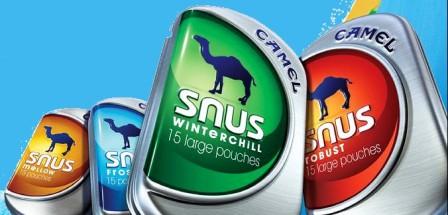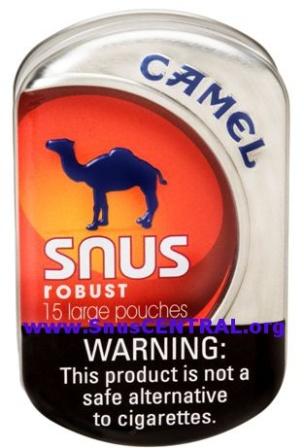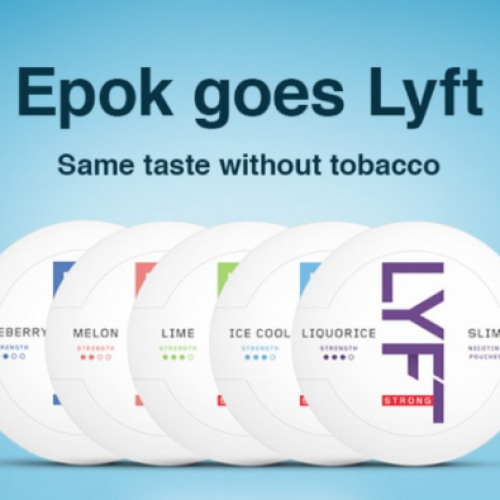Camel Robust and Winterchill SNUS – Is it Real Snus yet?
About five weeks ago, Reynolds American officially revealed the existence and national launch of two new Camel SNUS products: Camel Robust and Winterchill. Further, they redesigned the cans for the now four Camel SNUS products and tweaked their marketing back to the themes they stressed in 2007. Camel SNUS was not only a compliment to cigarettes as in the “When you can’t smoke, SNUS” campaigns of late but also acknowledged that snus was invented in Sweden hundreds of years ago. Borrowing a little from old Marlboro Snus advertising, Camel SNUS was now also “Swedish Snus….perfected.”
Fortunately for all of us, Reynolds was much more restrained in promoting that impossible statement then they were when I was forced to detail outrageous claims and parsed words on the former versions of the Camel SNUS websites. This is 2010 however, where the PACT Act and the Tobacco Control Act have hurt the price and availability of Internet snus and Swedish entrepreneurs; not manufacturers, are left to bring the truth about real snus to an American culture whose oral tobacco roots stop at dip and chewing tobacco.
What RJRT Did “Right” with Camel SNUS
Camel SNUS is becoming successful not because of the taste which is clearly inferior to Real Swedish snus. Not because of the SNUS manufacturing standards which I’ll address in a bit. Not because of the  available nicotine content which is much lower than Swedish snus. Not because it is an alternative for cigarette smokers because it’s not; American Big Tobacco pseudo-snus products are designed to be used with cigarettes; not in place of them. It’s not price since Camel SNUS and especially Marlboro’s snus-like product costs the consumer much more per gram than Swedish and Scandinavian Snus; even under the PACT Act. It definitely isn’t taste; of that I can assure you.
available nicotine content which is much lower than Swedish snus. Not because it is an alternative for cigarette smokers because it’s not; American Big Tobacco pseudo-snus products are designed to be used with cigarettes; not in place of them. It’s not price since Camel SNUS and especially Marlboro’s snus-like product costs the consumer much more per gram than Swedish and Scandinavian Snus; even under the PACT Act. It definitely isn’t taste; of that I can assure you.
What Reynolds did accomplish were a few key items…which changed the course of snus in America and will continue to for at least the next two to three years.
- Camel SNUS was launched with a long term vision and commitment. Reynolds was not afraid to lose money by being a ground-breaker in America. Lorillard and Triumph Snus; Liggett-Vector and Grand Prix just cut their losses and ran. Even PMUSA played Marlboro Snus much more conservatively than Reynolds did with Camel SNUS.
- After disappointing results with the original proto-type of Camel SNUS; a round-can Swedish snus made for them by BAT in Sweden, Reynolds decided to change the game. Instead of trying to beat Swedish Snus at it’s own game, they redefined the product. They changed the flavor profile from traditional Swedish to a weak and at times, sickly sweet taste….and they stuck with it. Some versions failed and were replaced until we arrive at the current product line. Who knows what that will look like a year from now? One thing we do know is that it will taste like SNUS; not Real Swedish snus.
- Like all Big American Tobacco, they never responded or asked for serious input from the consumers. That’s not the way it works in America. When only recently they began soliciting consumer input, it wasn’t to obtain feedback as much as it was to indoctrinate those new or just becoming curious about snus. SnusCENTRAL participated (more out of curiosity than anything else) in a 2010 effort which turned into anembarrassing soap opera which was cancelled after a few weeks.
- Reynolds always kept it’s eye on the ball and held to the long term success of the product. Camel SNUS lost money for RJRT. More Camel SNUS over the years has been given away to tobacco consumers than sold. SnusCIA analysts determined from information obtained via third party sources that Camel SNUS internal sales projections for 2010 have been revised down about 25%. You’d never know that from Reynolds or the convenience store displays or placement. Camel SNUS in it’s little refrigerator (sometimes its even plugged in!) and point of sale advertisements have prime placement. That costs money. Long term commitment to an inferior but ultimately valuable product line.
Camel roBUST and and WiNTERCHiLL SNUS: Is more SNUS better SNUS?
 One thing RJRT should do quickly is change product names in the graphics. Robust is spelled roBUST; I didn’t make that up. An inside joke by the graphic designer or was the graphic made by a secret Swedish snus user to make a statement? I have no idea but a lot of people who think Camel SNUS is a bust are having a good laugh at Reynolds expense.
One thing RJRT should do quickly is change product names in the graphics. Robust is spelled roBUST; I didn’t make that up. An inside joke by the graphic designer or was the graphic made by a secret Swedish snus user to make a statement? I have no idea but a lot of people who think Camel SNUS is a bust are having a good laugh at Reynolds expense.
Camel Winterchill and Robust both contain 15 portions per can, the same as Camel Mellow and Frost SNUS. The biggest difference is the Robust and Winterchill portions are one gram in weight as opposed to the 0.6 gram found in the Mellow and Frost. Interestingly, all four are retail priced at $3.99 plus tax in the Dallas/Fort Worth area.
Not content with the product information I found floating around cyberspace, I spoke with David Howard; Director of Communications for Reynolds American Services. To my surprise, he answered all my questions.
According to Howard, Camel Robust and Winterchill both contain 10.3 mg/g of total nicotine. Of that, 32% of the nicotine is bio-available or “free” nicotine. Swedish/Scandinavian one gram portions contain between 8mg/gr to 17mg/g total nicotine. However, thebio-available/free nicotine level in Swedish snus is generally 80% thanks to our little friend E500.
Camel SNUS also has a pH level of 34.3% compared to Swedish snuses 45% to 55% in one gram portions. That would put Camel Robust and Winterchill at best a little over 3mg/g of nicotine your body can use; the Frost and Mellow mini portions would come it at just under 2mg/g. This is obviously considerably less than Real Snus from Sweden/Scandinavia but in keeping with RJRT’s definition of SNUS: use it WITH your cigarettes; not as a replacement for your cigarettes.
When it comes to nitrosamine or TSNA levels; the substances which cause cancer in tobacco, I’ve seen 1.4 ppm thrown around which is acceptable but the nitrosamine levels at the factory don’t concern me. What concerns me are how dangerous is the product as it ages. Camel SNUS is now boasting expiration dates of a year out. The cans I have are marked June and May of 2011.
Whether or not the TSNA levels stay the same throughout it’s shelf life is determined primarily on how it is manufactured. American Dip like Copenhagen and Skoal have to be rotated off the shelves every 30 and 90 days respectively. Most Swedish/Scandinavian snus has an expiration date 16 weeks from leaving the factory with some coming in at the 6 to 8 month mark. The primary differentiator between American Dip and Swedish Snus is Pasteurization: Swedish Snus is; American dip is fermented. Add sugar and that’s why American dip does cause mouth cancer, tooth loss and gum disease where Swedish Snus does not. Here, RJRT takes us down a carefully worded road with major significance. They are certainly not the first. GN Tobacco of Sweden, makers of Olde Viking Snus, is the only known Swedish snus manufacturer who does not Steam Pasteurize their snus but Heat Pasteurizes it. Their reasoning is probably the same RJRT is using: cost.
Why Should I care How a Snus/SNUS is Pasteurized?
My article on Olde Viking Snus details so-called heat pasteurization. In short, both heat and steam pasteurization destroy most nitrosamines. Steam pasteurization takes that one step further and destroys the micro-organisms which create nitrosamines. Olde Viking Snus has a TSNA level of 0.5 which is excellent…at the factory. Since it is heat pasteurized, the TSNA levels will start climbing the older the snus gets; even sealed in a can. As long as there is air in the can, it doesn’t matter how good the seal: the TSNA’s will rise.
The reason you should care is because in the case of Camel SNUS, the expiration dates run out up to a year. In the case of Olde Viking, any cans I’ve purchased for test purposes have a place for the Best Before date but no date is printed there. If Camel SNUS contains 1.4 ppm when it leaves the factory, what will that level be 3 months later? Six months later? A year later?
I asked Mr. Howard if Camel SNUS was Pasteurized. He responded yes. I asked him if it was Steam Pasteurized. He responded equally as clearly that Camel SNUS was Heat Pasteurized. I later asked him if the tobacco used in Camel SNUS was air-cured (which is good) or fire-cured (which is not). He responded that Camel SNUS tobacco was “heat-cured”. In cases like this where clarity is needed, I turn to our resident tobacco historian and expert, R.R. Hubbard. With his usual directness, here is what he had to say and it’s not good for Americans.
“Heat cured is the same as flue cured. The difference between flue cured and fire cured is that fire cured tobacco is hung up and literally heated by a controlled bonfire on the barn floor. Flue cured is pretty much the same thing, except indirect heat is used to cure it, usually from big kerosene heaters that have radiator pipes running around the top and sides of the barn where the tobacco hangs.
Fire cured tobacco has the highest amount of TSNAs, and flue cured is a close second. I don’t touch fire cured tobacco at all (American nasal snuff and British pipe tobacco) and I shy away from flue cured tobacco (pretty much ALL American oral snuff, cheap cigarette tobacco). The dangerous thing about heat cured tobacco is that it absorbs all the chemicals in the smoke or the kerosene that is used to cure it, so in addition to raising the TSNA count, you have all kinds of unnatural, carcinogenic compounds that creep into the leaf.
It all makes sense now. Originally Camel SNUS was almost all air cured Burley (which is what is used in Doral cigarettes and grown in the USA) and I believe that the air-cured leaf is what helped give Camel SNUS its initially low TSNA count. Now the cans say “100% foreign tobacco” which puzzled me, because this meant that they probably stopped using cigarette tobacco for SNUS.
What I think has happened is that RJR tired of reading criticisms leveled at the type of tobacco they used in Camel SNUS, so they’re channeling Malawai tobacco (which is almost entirely flue cured) that they use in their American Snuff Co products into their Camel SNUS. This would possibly mean that (A) the tobacco should be much more moist than it used to be and (B) the TSNA count is probably twice as high as it once was, since we now have heat cured tobacco instead of air cured tobacco.”
The bottom line is that for cigarette smokers, real Swedish snus is 98% less harmful to them than smoking. Camel SNUS is not. Despite FDA’s incorrect warning labels, in the 40 years Swedish Snus has been regulated as a Food Product by the Swedish government, there have been no documented cases of mouth, throat, lung, or stomach cancer. That’s why the Swedish equivalent of our FDA removed the cancer warning from Swedish snus a few years ago.
Is the New Camel SNUS a Better SNUS…or even a snus?
I confess I finally located Robust and Winterchill about 10 days ago. They’ve been sitting in my snus fridge quarantined from my Real Snus staring at me. I just couldn’t bring myself to open the cans. I still bear the emotional scars of my first Camel Frost encounter. I found both Robust and Winterchill to be very artificial tasting and overly sweet. No big surprise. They didn’t make me sick like Camel Frost did the first time I tried it but one gram of SNUS also didn’t satisfy my nicotine needs.
The Winterchill did achieve a first for me, I will admit. I hate the flavor of wintergreen. There are a number of Swedish snuses flavored with Wintergreen now and I can’t keep any of them in my mouth for more than 55 seconds without gagging. Camel Winterchill SNUS stayed in my mouth for 45 minutes. It did not make me sick. It did become annoying after a while but tasted more like toothpaste than wintergreen to me. Thinking about that, it scares me that the taste was so unlike wintergreen to me yet marketed as a wintergreen. Is this what they think wintergreen is supposed to taste like? What exactly did RJRT use to flavor Winterchill?
I was able to keep the Robust in as well. The taste almost reminded me of the late Camel Spice but since Spice only had 0.4 grams of SNUS, I never really tasted it well enough to say with certainty. Any tobacco taste to the Robust was overwhelmed by cloying sweetness. This is probably a good thing for Reynolds since my 3rd portion of Robust I kept in until the flavor faded…what was left was very bitter. This does not speak well of the tobacco used.
Both were no more flavorful or intense than earlier SNUS products even though they contained a full gram of ……SNUS. The portion pouches were designed to look like they contained more than a gram of snus. The pouches were somewhat hard on the gums until they became saturated but nothing really painful like the original long, thin style pouches used with their mini portions.
After dissecting a portion of Winterchill, I confirmed one of Hubbard’s theories: the SNUS was moister than previous versions and less pelletized. It almost looked like real tobacco instead of dirt. When it comes to presentation, RJRT did move up a step with the latest versions.
As to aroma, the Robust had virtually none. Winterchill on the other hand, began reeking as soon as I broke the seal. Opening the can, I smelled it up close and my lips went numb. Overpowering is appropriate word for polite company, I believe. Remember, I am a professional. Do NOT try strongly inhaling once opening Winterchill at home.
What advertising slogans would be truthful concerning the newest SNUS? “It won’t make you puke but you’ll still crave nicotine”. “Remember your very first cigarette? Taste didn’t matter then either!” “We didn’t perfect Swedish Snus; we just compare our completely different product to it”. “We’re only less harmful than cigarettes if you don’t light SNUS on fire and inhale”.
The new Camel SNUS is a better SNUS than previous incarnations but is by no stretch of the imagination a real snus. Camel SNUS and Marlboro Snus can’t really be compared to Real Snus from Sweden since they really are completely different products. When I wrote about my first snus experience back in 2007, I compared Camel and General portion as dog food to a porterhouse steak. Doing the same analogy today, dog food would become cat food. Grandma may be able to tolerate the taste out of necessity but it’s still not fit for human consumption.
You’ll continue to hear a lot from RJRT and Altria about “reduced harm” in relationship to Camel and Marlboro snus going forward. Their products may be less harmful than cigarettes or dip, but certainly not compared to Real Swedish/Scandinavian Snus.
I’ve sent samples of both Camel SNUS and Marlboro Snus to a laboratory for nicotine testing. I should have the results in about 3 weeks. Once I receive them, I’m going to do something I never in my wildest nightmares imagined. I’m going to write a review of Camel Robust vs Marlboro Rich. There is a chance I won’t survive that comparison. If nothing else, my tastebuds will be at least temporarily damaged.
Real snus lovers have been pummelled with bad news this year: The Tobacco Control Act, the PACT Act, access to Real snus diminished, price increases; many snusers have lost heart over the last few months. I confess I am one of them. My descent into American psuedo-snus culminating in the Camel SNUS versus Marlboro Snus review is my spiritual walk into the wilderness. I will return stronger in my belief in real reduced harm tobacco products; stronger in my gratitude to Swedish snus for saving me from 35 years of cigarettes….or I may perish in the attempt. I’ve become complacent and my Government has betrayed me. It’s my time to cross the Rubicon.
Cleansing my mouth with Gustavus Original Portion,
LARRY WATERS
Activist Snus Lord
Shining the Light of Truth from SnusCENTRAL.org
About author
You might also like
JTI Sweden – Interview with Snus Lord Per Andersson
Much has changed for tobacco users in the month since I first started this article. The Tobacco Act and the PACT Act are the law of the land….sort of. Both
Why did BAT kill the EPOK brand for LYFT?
All White tobacco and all white nicotine products have been around for some time. Early examples go back to 1999 with the introduction of Nicorette. Later offerings of all white
Swedish Match & Philip Morris International Announce Joint Venture: a Match made in….Sweden?
Since February 3rd, 2009 I’ve been investigating the shocking yet exciting announcement from Swedish Match and Philip Morris International that they were entering into a joint venture to market snus


